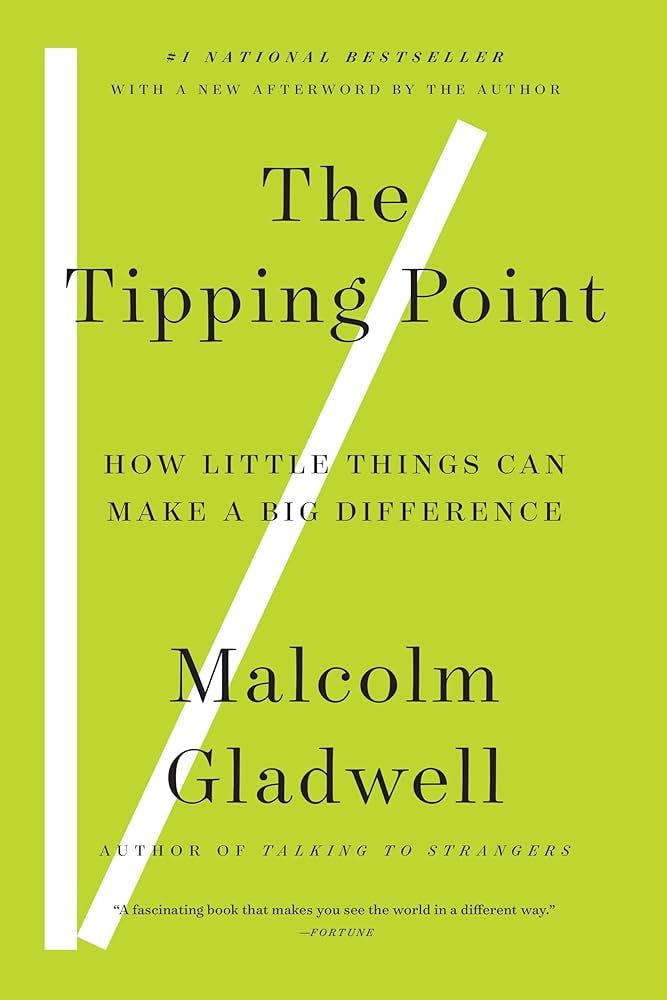The Book in Three Sentences
Ideas, products, messages and behaviors spread just like viruses do, you can think of them as epidemics. The tipping point is a dramatic moment in an epidemic when everything can change all at once. The three rules of the tipping point are the Law of the Few, the Stickiness Factor, and the Power of Context.
The Tipping Point Summary
This is my book summary of The Tipping Point by Malcolm Gladwell. My notes contain best quotes from the book and the key lessons in my view.
The Law of the Few
Word of mouth is still the most important form of human communication - even in this age of mass communication and multi-dollar advertising campaigns.
The success of any kind of social epidemic is dependent on a few people - Connectors, Mavens and Salesmen.
A very small number of people are linked to everyone else in a social group, and the rest of us are linked to the world through the special few. We call these people Connectors; people with a special gift of bringing the world together.
You social circle, in reality, is not a circle, it’s a pyramid. At the top of pyramid is a single individual who is responsible for a majority of the relationships that constitute your life.
We are friends with the people we do things with, as much as we are friends with the people we resemble. We don’t seek out friends, in other words. But connectors don’t shy away from making as many acquaintances as possible. They are happy with ‘weak ties’.
A job search experiment shows that people don’t get jobs though their friends, they get them through their acquaintances.
Acquaintances represent a source of social power, the more acquaintances you have the more powerful you are for they give you access to opportunities and worlds you don’t belong to.
Mavens are the people with the most information in a social group. They are the people who keep the market honest by finding rare deals and complaining if there are discrepancies.
A maven wants to solve other people’s problems , generally by solving his own. To be a maven is to be a teacher motivated by the need to educate and to help.
In a social epidemic, Mavens are data banks: they provide the message. Connectors are social glue: they spread it. Salesmen are the persuaders: they convince us when we are hesitant about what we are hearing.
The Stickiness Factor
In epidemics, the messenger matters: messengers are what make something spread. But the content of the message matters too. And the specific quality that a message needs to be successful is the quality of “stickiness”.
Stickiness makes a message memorable, and memorability spurs people to change.
The lesson of stickiness is that there is a simple way to package information that, under the right circumstances, can make it irresistible.
The Power of Context
Epidemics are sensitive to the conditions and circumstances of the times and places in which they occur.
An epidemic can be created or reversed by tinkering with the smallest details of the immediate environment.
When it comes to interpreting people’s behavior, human beings make the mistake of overestimating the importance of fundamental character traits and underestimating the importance of situation and context. This is called the Fundamental Attribution Error.
Character is a bundle of habits and tendencies and interests, loosely bounded together and dependent, at certain times, on circumstance and context.
Environmental tipping points explain that peer influence and community influence are more important than family influence in determining how children turn out.
If you want to bring about a fundamental change in people’s beliefs and behavior, a change that would persist and serve as an example to others, you need to create a community around them, where those new beliefs could be practiced and expressed and nurtured.
The Rule of 150 distinguishes a group with real social authority from a group with little power. People in groups below 150 are able to bond and know each other well enough that what they think of you matters.
Peer pressure is much more powerful than the concept of a boss as people want to live up to what is expected of them.
Conclusion
The Tipping Point is filled with examples and case studies backing up the three rules of social epidemics. It is an exciting ‘scientific’ book that challenged me to look at change within social groups in a different lens. The examples are great but I couldn’t relate to any of them (they're from an American perspective). Malcolm Gladwell writes in an interwoven way that can sometimes be difficult to find the main ideas so this was a tough book to summarize but was worth the effort.




